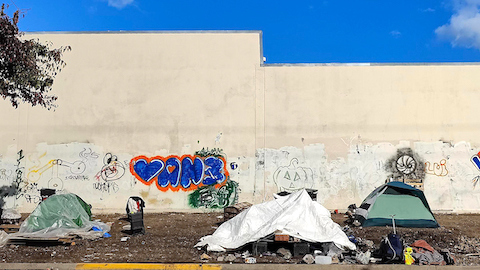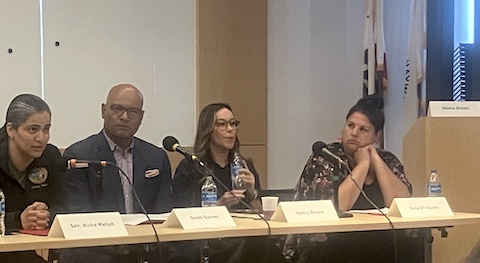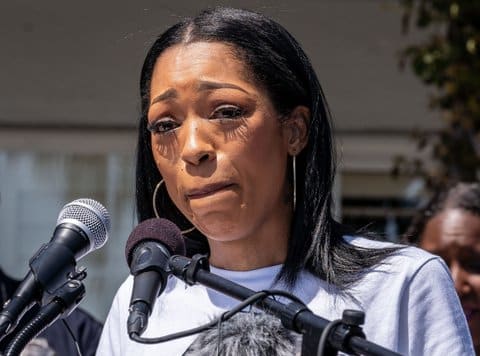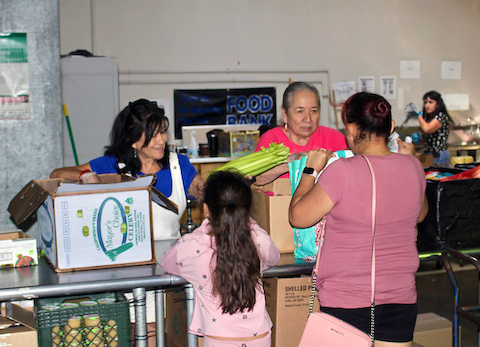
19 Nov ‘People Are Going to Die’: Bay Area Homelessness Leaders Speak Out About HUD Cuts

A homeless encampment in San Rafael on Nov. 18. (George Alfaro / Bay City News)
By Aly Brown
Bay City News
Leaders from homelessness response networks across the Bay Area are still reeling from the announcement of sweeping changes to the federal grant system that arrived late last week.
Since learning of the new requirements from the U.S. Department of Housing and Urban Development on Thursday, directors from local Continuum of Care agencies now must figure out how they will serve their communities with guaranteed funding slashed from 90% to 30% — all while living in a blue region where their own state laws, like those on diversity, equity and inclusion, could put them out of compliance.
CoCs are regional planning bodies that coordinate state and federal funding for local projects that address homelessness. In the densely populated Bay Area, counties each have their own CoC, but that is not necessarily the case in rural areas.
The recent changes mark a stark departure from previous housing-first responses to homelessness. HUD now calls for CoCs to spend no more than 30% on permanent housing, including permanent supportive housing, rapid rehousing and joint transitional housing/rapid rehousing.
The Notice of Funding Opportunity, or NOFO, released by HUD states that CoCs should instead devote resources to projects that “promote self-sufficiency, increase employment income over government assistance, and promote treatment and recovery.”
In a statement, HUD Secretary Scott Turner said his department’s philosophy for addressing the homelessness crisis will now “define success not by dollars spent or housing units filled but by how many people achieve long-term self-sufficiency and recovery.”
“We are stopping the Biden-era slush fund that fueled the homelessness crisis, shut out faith-based providers simply because of their values, and incentivized never-ending government dependency,” Turner said. “These long-overdue reforms will promote independence and ensure we are supporting means-tested approaches to carry out the president’s mandate, connect Americans with the help they need, and make our cities and towns beautiful and safe.”
But for Michael Gause, ending homelessness manager for the Sonoma County Department of Health Services, the changes felt like a gut punch after years spent helping to stabilize people who were once chronically homeless. In a normal year, $3.3 million of the $4 million in HUD renewal funds Gause’s agency receives — or 82.5% — goes to permanent housing, and they will now need to operate with much less.
“I’m just going to say it: people are going to die … We have 209 people in those (permanent housing) units, and every one of them has a disability,” Gause said. “One project is for people with HIV and AIDS. One has upwards of 50 veterans. One has 16 youth ages 18 to 24 with serious disabilities. We’re talking about people losing their housing, going back on the streets.”
Every year, HUD requires CoCs to place their funding requests in two tiers — Tier 1 for high-priority projects that are considered basically guaranteed for funding and Tier 2 for remaining project requests. Gause explained that, historically, Tier 1 made up about 90-95% of the funding renewal, but this year it’s 30% — meaning only 30% of funding is now guaranteed.
Claire Cunningham, San Mateo County’s Human Services Agency director, expressed deep concern about the impact the federal changes may have on the families served in her county.
“At stake is nearly $18 million in federal funds per year that support programs for unhoused adults and families throughout the county. San Mateo County families, many of whom are already navigating multiple barriers rooted in structural inequities, could be affected,” Cunningham said. “Our priority is to protect their stability, dignity and well-being. We remain committed to working with our partners to ensure families continue to receive the support and housing resources they need.”
The NOFO outlines scoring criteria that favor projects without diversity, equity and inclusion, or DEI, policies, citing the executive order titled “Ending Radical and Wasteful Government DEI Programs and Preferencing” by President Donald Trump.
“In areas like California, or other blue states that have policies that are now contrary to what they want, you’re going to score lower in the overall application, thus run the risk of losing more funding,” Gause said.
The issuance — or re-issuance — of the NOFO in alignment with the Trump Administration policies was in itself an expensive about-face for CoCs.
Christy Saxton, Contra Costa Continuum of Care director, said under former President Joe Biden’s administration last year, HUD had announced a two-year cycle for applications — a move that would have saved her agency about $30,000 in application expenses by the time staff time and consultants’ contracts are paid over the months-long process of preparing the material for submission.
“We were planning for a two-year process, as opposed to a one-year, making sure all of our projects were lined up to be meeting what HUD had dictated to us that they wanted, which was permanent supportive housing, housing first and evidence-based practices,” Saxton said. “We are now going into year two, and we were told mid-summer to expect a new Notice of Funding Opportunity.”
The new applications are due in January, and the HUD NOFO cites May 1 as the anticipated award date. However, January marks the end of many grant-funded project cycles.
“That’s months of no funding,” Saxton said.
In Contra Costa County, about 92% of the HUD-funded projects support permanent housing. Saxton said cuts could impact about 3,000 people, including 900 who were chronically homeless and had become stable again. She highlighted impacts that could further extend to landlords.
“We are not a community with huge corporations with big housing projects,” she said. “A lot of our HUD-funded apartments are mom ‘n’ pop.”
Saxton and Gause agreed they weren’t opposed to changes within HUD as long as CoCs were given the chance to adjust without impacting their service population.
“If HUD wants to change how they want to do things, that is the right of any administration,” Saxton said. “All we’re asking is honor what Congress has already appropriated to us and then give us a year while you make those changes, so it can be done through a community process. All of this is run as a community process, and that’s being stripped away from our community.”
Copyright © 2025 Bay City News, Inc. All rights reserved. Republication, rebroadcast or redistribution without the express written consent of Bay City News, Inc. is prohibited. Bay City News is a 24/7 news service covering the greater Bay Area.






No Comments